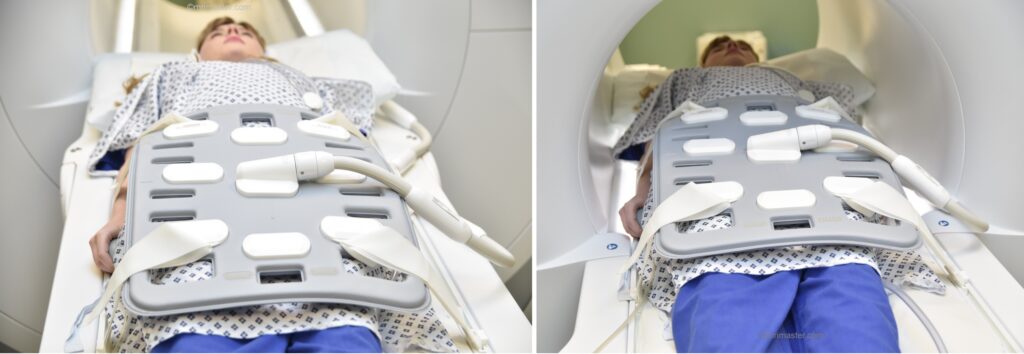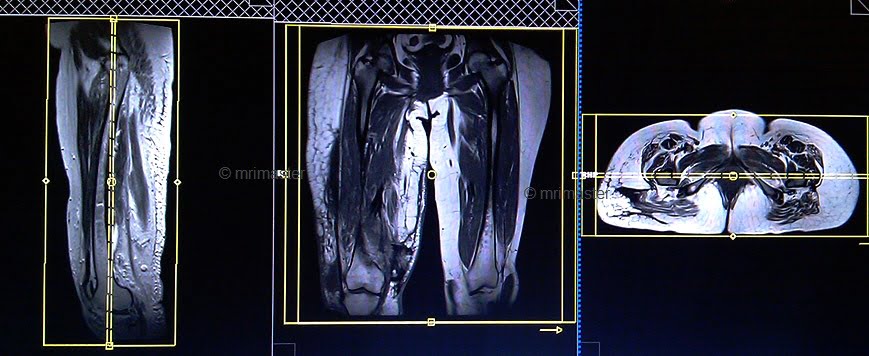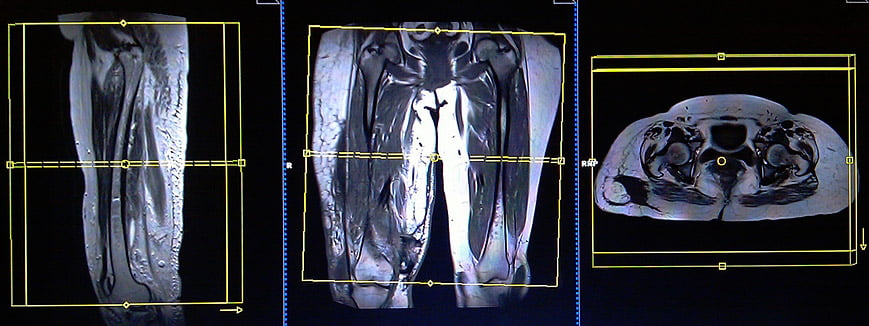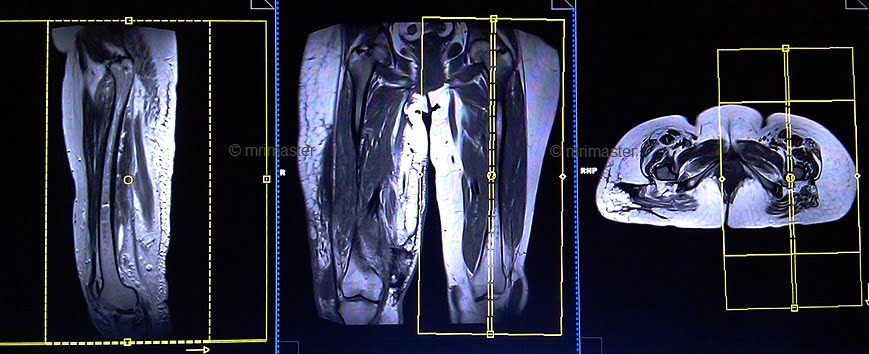MRI Thigh (Upper Legs) Protocols and Planning
Indications for mri thigh scan
- Marrow abnormalities: avascular necrosis, marrow edema syndromes, and stress fractures
- Muscle and tendon disorders: strains, partial and complete tears, tendonitis, tendonopathy
- Congenital and developmental conditions
- Neoplasms of bone, joint or soft tissue
- Infections of bone, joint or soft tissue
- Myositis and osteomyelitis
- Hamstring injury
- Ligament tears
- Acute trauma
- fractures
- Abcess
- Ulcer
Contraindications
- Any electrically, magnetically or mechanically activated implant (e.g. cardiac pacemaker, insulin pump biostimulator, neurostimulator, cochlear implant, and hearing aids)
- Intracranial aneurysm clips (unless made of titanium)
- Pregnancy (risk vs benefit ratio to be assessed)
- Ferromagnetic surgical clips or staples
- Metallic foreign body in the eye
- Metal shrapnel or bullet
Patient preparation
- A satisfactory written consent form must be taken from the patient before entering the scanner room
- Ask the patient to remove all metal object including keys, coins, wallet, any cards with magnetic strips, jewellery, hearing aid and hairpins
- If possible offer some one in the scanner room for claustrophobic patient (e.g. relative or staff ).
- Offer earplug or headphones possibly with music for extra comfort.
- Properly explain the procedure to the patient
- Instruct the patient to keep still
- Note the weight of the patient
Positioning for mri upper legs
- Position the patient in supine position with feet pointing towards the magnet (feet first supine)
- Position the patient over the spine coil and place the body coils over the thighs (anterior superior iliac spine down to knee joints)
- Securely tighten the body coil using straps
- Centre the laser beam localizer over the mid thigh

Recommended MRI Thigh (Hamstring ) Protocols and Planning
MRI Thigh Localizer
A three-plane localizer must be taken at the beginning to localize and plan the sequences. Localizers are normally less than 25 seconds and are T1-weighted low-resolution scans.

T2 stir coronal 5mm 460-470 FOV
Plan the coronal slices on the axial plane, and angle the positioning block parallel to the right and left hip joints. Check the positioning block in the other two planes. Ensure an appropriate angle is given in the sagittal plane (parallel to the femoral shaft). The slices must be sufficient to cover the entire thigh from anterior to posterior. The FOV must be large enough to cover the entire thigh, from the hip joints down to the knee joints.

Parameters
TR 5000-6000 | TE 110 | FLIP 150 | NEX 2 | SLICE 5 MM | MATRIX 448X384 | FOV 460-480 | PHASE R>L | GAP 10% | TI 150 |
T1 tse coronal 5mm 460-470 FOV
Plan the coronal slices on the axial plane, and angle the positioning block parallel to the right and left hip joints. Check the positioning block in the other two planes. Ensure an appropriate angle is given in the sagittal plane (parallel to the femoral shaft). The slices must be sufficient to cover the entire thigh from anterior to posterior. The FOV must be large enough to cover the entire thigh, from the hip joints down to the knee joints.

Parameters
TR 400-600 | TE 15-25 | SLICE 5 MM | FLIP 160 | PHASE R>L | MATRIX 512X448 | FOV 460-480 | GAP 10% | NEX(AVRAGE) 2 |
T1 tse axial 6mm 450-470 FOV
Plan the axial slices on the coronal plane and angle the positioning block parallel to the right and left hip joints. Check the positioning block in the other two planes. An appropriate angle must be given in the sagittal plane (perpendicular to the femoral shaft). The slices must be sufficient to cover the entire thigh from the hip joints down to the knee joints. In the case of localized pathology, focus the axial block solely on that specific area.

Parameters
TR 400-600 | TE 15-25 | SLICE 6 MM | FLIP 160 | PHASE A>P | MATRIX 512X448 | FOV 400-470 | GAP 10% | NEX(AVRAGE) 2 |
T2 stir axial 6mm 450-470FOV
Plan the axial slices on the coronal plane and angle the positioning block parallel to the right and left hip joints. Check the positioning block in the other two planes. An appropriate angle must be given in the sagittal plane (perpendicular to the femoral shaft). The slices must be sufficient to cover the entire thigh from the hip joints down to the knee joints. In the case of localized pathology, focus the axial block solely on that specific area.

Parameters
TR 5000-6000 | TE 110 | FLIP 160 | NEX 2 | SLICE 6 MM | MATRIX 448X448 | FOV 400-470 | PHASE A>P | GAP 10% | TI 150 |
T2 tse sagittal 5mm right
Plan the sagittal slices on the coronal plane; angle the positioning block parallel to the femoral shaft. Check the positioning block in the other two planes. An appropriate angle must be given in the axial plane (vertically across the right thigh). Slices must be sufficient to cover the right thigh from medial to the lateral aspect.

Parameters
TR 4000-5000 | TE 100-120 | SLICE 5 MM | FLIP 130-150 | PHASE A>P | MATRIX 512X448 | FOV 460-480 | GAP 10% | NEX(AVRAGE) 2 |
T2 tse sagittal 5mm left
Plan the sagittal slices on the coronal plane; angle the positioning block parallel to the femoral shaft. Check the positioning block in the other two planes. An appropriate angle must be given in the axial plane (vertically across the left thigh). Slices must be sufficient to cover the left thigh from medial to the lateral aspect.

Parameters
TR 4000-5000 | TE 100-120 | SLICE 5 MM | FLIP 130-150 | PHASE A>P | MATRIX 512X448 | FOV 460-480 | GAP 10% | NEX(AVRAGE) 2 |


